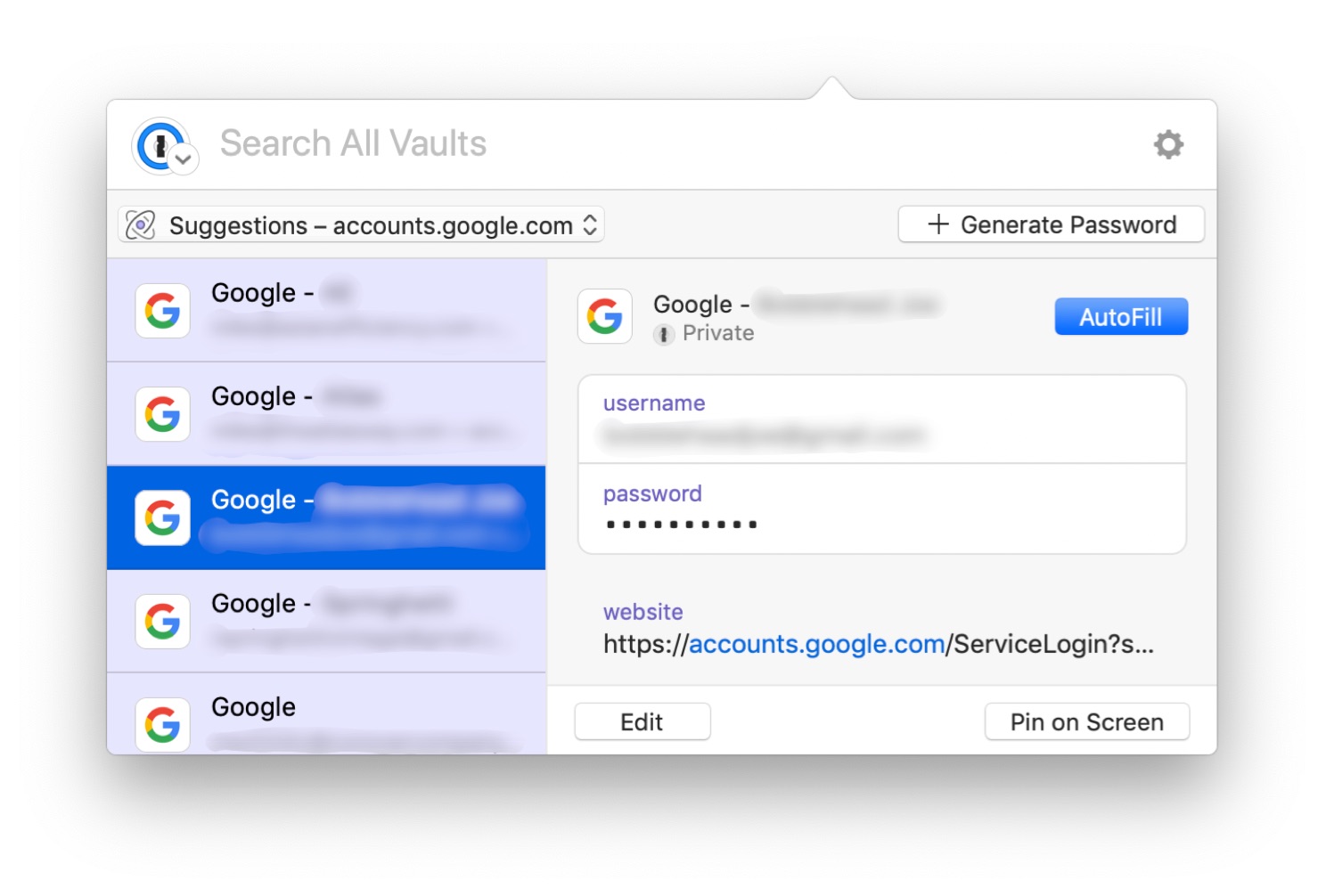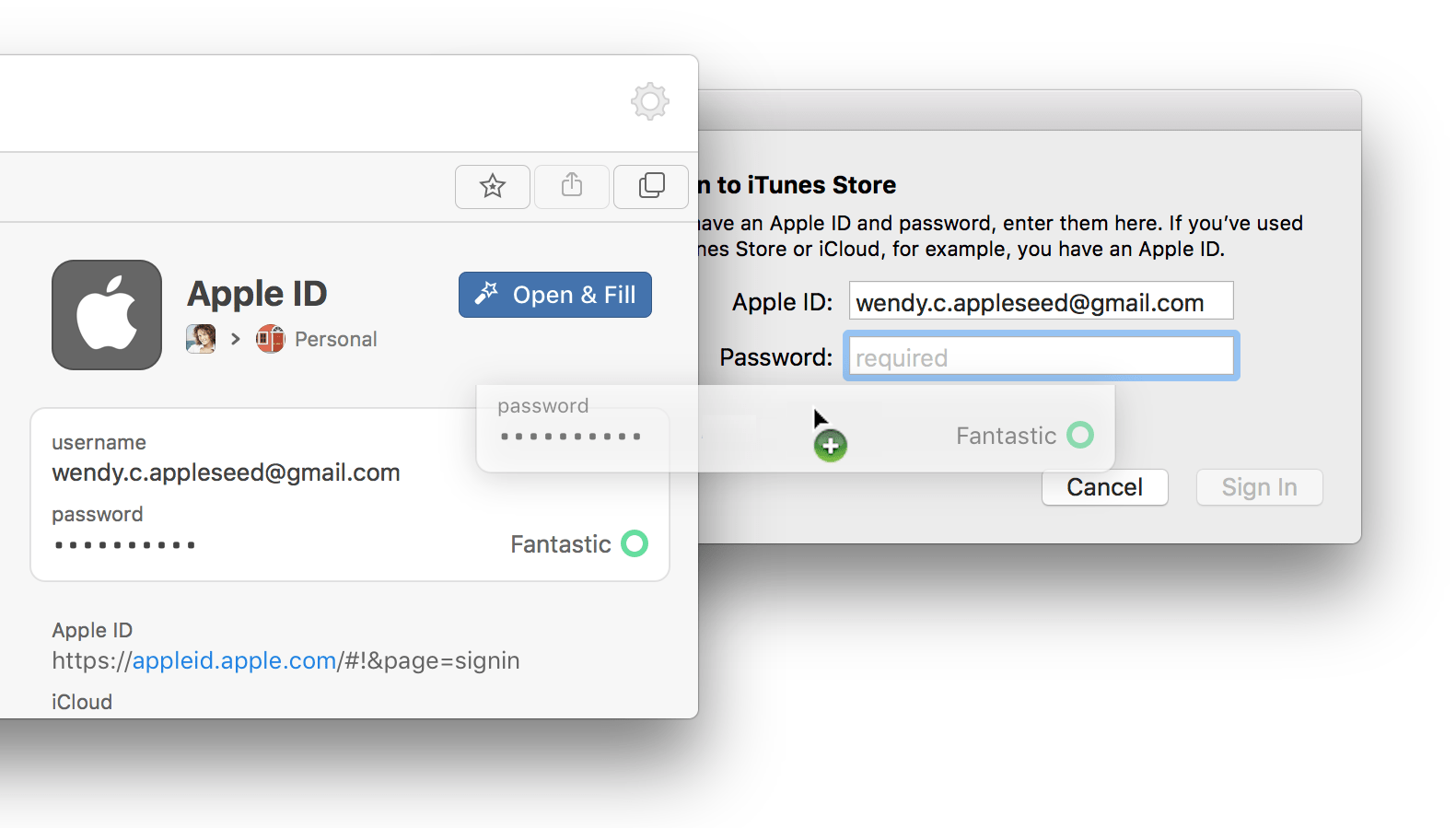1Password is a password management for Mac that allows you to store sensitive information in a very efficient way, such as password and bank account numbers. It counts with an auto-complete function that allows you to automatically fill in the login forms and the registry of any web service. The password generator included in 1Password can create random passwords by following the criteria indicated. You can now unlock 1Password from your Apple Watch on any Mac laptop with Touch ID, and many newer models of Mac mini, iMac, and Mac Pro. The best part is Unlock with Apple Watch works in concert with Touch ID, meaning you will get a prompt for both, and using either will unlock 1Password. Learn how to sync 1Password across all your devices: Macs, Windows PCs, iPhones, iPads, and Android phones. When you have a 1Password membership, you can access your data everywhere you need it. Any changes you make on one device are immediately available everywhere else. There’s no limit to the number of devices where you can use 1Password.
1Password for Mac is the simple, beautiful password manager you’ve been looking for. Easily organize your secure information, save and fill passwords in your browser, and have everything available at your fingertips.
Before you get started, set up 1Password on your Mac.

Create and edit items
When you open 1Password, you’ll see a list of all your items, like your passwords and credit cards. Select an item to see its details:
To create an item, click or choose File > New Item (Command-N). Then choose the type of item to create. Enter the details and click Save.
To edit an item, select it and click Edit or choose Item > Edit (Command-E). When you’re done making changes, click Save or choose Item > Save Changes (Command-E).
To see only certain types of items, select a category in the sidebar. Select All Items to see everything in the current vault.
Use 1Password in your browser
1Password lets you fill passwords, credit cards, and addresses directly in your browser.
Use 1Password mini to fill in apps
1Password mini makes it easy to fill your details in apps. To open 1Password mini, click the 1Password icon in the menu bar (Option-Command-Backslash ()).
To fill in an app, drag your login details to it. For example, drag your password to the password field in the app.
To keep your login details handy, click Pin on Screen to open them in a separate window. You can close the window when you’re done.
Search 1Password
Searching is the fastest way to find what you need in 1Password.
To search in 1Password, use the search field above the list of items (Command-F).
Sort items
To change how items are sorted in the list, click “items sorted by” below the search field.
Each category has different sort options, and they can be set per category. For example, you can sort credit cards by card type and logins by date last used.
Organize with favorites and tags
You can organize your items with tags or mark them as favorites to quickly access them when you need them.
To mark an item as a favorite, select it and clickin the top right. Or drag items onto Favorites in the sidebar.
To create a tag, edit an item, enter the name of the tag in the tag field, and click Save. Your tags automatically appear in the sidebar.
Switch vaults and accounts
You can use vaults in 1Password to organize your items and share them with others. If you have multiple 1Password accounts, each account has its own vaults.
To switch to a specific vault or view items from all the vaults in an account, click All Vaults (Command-L) at the top of the sidebar and choose a vault or account. Or choose Vault > Switch to Vault (Command-1 to Command-9).
Move and copy items
You can use drag and drop to move and copy items between vaults and even create new vaults.
1password Mac M1
Use Watchtower
Watchtower tells you about password breaches and other security problems on the websites you have saved in 1Password.
To get alerted when a website you have an account for is added to Watchtower, go to Preferences > Notifications and turn on Watchtower Alerts.
Format secure notes
Add formatting to your secure notes with Markdown. View them in rich text, complete with headers, bold and italic styles, lists, and more.
Enlarge passwords
You can temporarily enlarge a password to make it easier to see while entering it on another device or reading it aloud.
To enlarge a password, hover over it. Then clickand choose Show in Large Type.
Delete items
To move an item to the Trash, drag it to the Trash in the sidebar. Or choose Item > Move to Trash (Command-Delete).
To restore an item from the Trash, click the Trash in the sidebar, select the item, then click Restore. Or choose Item > Restore from Trash.
To delete the items in the Trash, choose 1Password > Empty Trash.
Lock 1Password
When you’re done using 1Password, you can lock it. To lock 1Password, choose 1Password > Lock (Control-Option-Command-L). Unlock 1Password again by entering your Master Password.
Learn more
Before you begin

Make sure that your Mac is connected to the internet and using macOS Catalina or later. If using an earlier macOS, follow the password-reset steps for macOS Mojave or earlier.
Choose a reset option from the login window

One Password Mac
To see one of the following password-reset options, click the question mark next to the password field in the login window. If you don't see a question mark, enter any password three times.
If you see the option to reset using your Apple ID
- Click the option to reset using your Apple ID, then proceed as follows:
- If your Mac restarts, skip to the next section, “If you see the option to restart and show password options.”
- If your Mac doesn't restart, but immediately asks for your Apple ID credentials, enter that information and click Reset Password.
- If you're asked to create a new keychain to store the user's passwords, click OK to restart your Mac.
- If you're asked to select an admin user you know the password for, click “Forgot all passwords?”.
- If you see a Reset Password window with the option to Deactivate Mac, click Deactivate Mac, then click Deactivate to confirm.
- Enter your new password information, then click Next.
If this window shows multiple user accounts, click the Set Password button next to each account name, then enter the new password information for each account. - When the password reset is completed, click Restart.
If you see the option to restart and show password options
- Click the option to restart and show password reset options, then wait for your Mac to restart.
- You're then asked to take one of these steps:
- Sign in with your Apple ID. You might also be asked to enter the verification code sent to your other devices.
- Enter your FileVault recovery key. You received it when you turned on FileVault and chose to create a recovery key instead of allowing your iCloud account (Apple ID) to unlock your disk.
- Select a user that you want to reset the password for, then click Next.
- Enter your new password information, then click Next.
- When the password reset is completed, click Restart.
If you see the option to reset using your recovery key
- Click the option to reset using your recovery key, then enter your FileVault recovery key. You received it when you turned on FileVault and chose to create a recovery key instead of allowing your iCloud account (Apple ID) to unlock your disk.
- Enter your new password information, then click Reset Password.
If you can't reset your password

Learn what to do if you can't reset your password.
